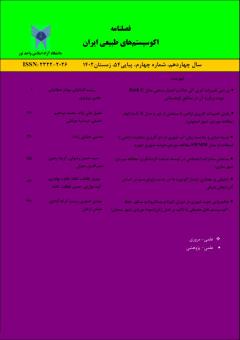شبیه سازی و مقایسه روان آب شهری در دو حالت کاربری اراضی با استفاده از مدل SWMM مطالعه موردی:حوضه شهری جهرم
محورهای موضوعی : کاربری اراضی
1 - گروه فنی مهندسی، واحد لارستان، دانشگاه آزاد اسلامی، لارستان
کلید واژه: حوزه آبریز شهری, کاربری اراضی, مدل SWMM, کالیبراسیون, آنالیز حساسیت,
چکیده مقاله :
سیلاب و آب گرفتگی در مناطق شهری در اثر رگبارهای شدید مشکلات فراوانی را برای بسیاری از شهرها به وجود میآورد. افزایش شهرنشینی، تغییرات کاربری اراضی و توسعه اراضی غیر قابل نفوذ روی مناطق نفوذپذیر اثرات مهمی در وقوع این خطر دارند. مدل مدیریت سیلاب(SWMM) یک مدل هیدرودینامیک شبیه سازی زهکشی و رواناب شهری بوده که به صورت گسترده ای جهت طراحی ها و آنالیزهای مختلف به کار گرفته می شود. در این مقاله دو نوع کاربری اراضی (سال 1344و 1400) شهر جهرم جهت مطالعه خصوصیات روان آب برای 5 رخداد بارندگی انتخاب شدند.آنالیز حساسیت پارامترهای تولید رواناب انجام شده و با استفاده از مدل SWMM پارامترهای بهینه تعیین شدند. نتایج بررسی تغییر کاربری اراضی نشان داد که بیشترین تغییر مربوط به تبدیل باغها و مراتع به اراضی مسکونی و تجاری است به طوری که سطح باغهای شهری 5 برابر کاهش یافته و همین عامل باعث افزایش حجم سیلاب شهری شده است. همچنین پس از اعتبار سنجی و کالیبراسیون مدل SWMM ، مقدار ضریب کارایی ناش ساتکلیف برابر با 88/0 و مقدار R2 برابر 91/0 بدست آمد که نشان از کارایی و مناسب بودن مدل برای حوضه شهری جهرم می باشد. در نهایت نتایج آنالیز حساسیت نیز نشان داد که پارامترهای درصد اراضی غیر قابل نفوذ و مقدار ذخیره بیشترین حساسیت را در دبی اوج سیلاب و ضریب زبری مانینگ کمترین تاثیر را داشته است.
Floods and flooding in urban areas caused by intense rain events has created problems for entire cities. Increasing urbanization, changes in land use, construction unprincipled and impervious land development on vulnerable areas have important effects on the occurrence of this risk. The Storm Water Management Model (SWMM) is a hydrodynamic model for simulating urban drainage and runoff, which is widely used for different designs and analyses. In this article, two types of land use (years 1344 and 1400) of Jahrom city were selected to study the characteristics of water runoff for 5 rainfall events. The sensitivity analysis of runoff production parameters was performed and the optimal parameters were determined using the SWMM model. The results of the land use change study showed that the biggest change is related to the conversion of gardens and rangelands into residential and commercial lands, so that the area of urban gardens has decreased 5 times, and this factor has caused an increase in the volume of urban flooding. Also, after the validation and calibration of the SWMM model, the Nash-Sutcliffe efficiency (NSE) was equal to 0.88 and the R2 value was equal to 0.91, which shows the efficiency and suitability of the model for Jahrom urban basin. Finally, the results of the sensitivity analysis also showed that the parameters of the imperviousness and the depression storage were the most sensitive in the peak flood discharge and Manning's roughness coefficient had the least effect.

